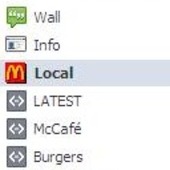Will Facebook's iFrames Kill Brand Sites?
Mark-up language shake-up lets marketers optimize pages and track conversions on the social site.
Mark-up language shake-up lets marketers optimize pages and track conversions on the social site.
Industry players have pondered whether Facebook could become the Internet’s central location for content, e-commerce, advertising, and messaging since it announced its “open graph” strategy last April. When the Palo Alto, CA-based company revealed on Feb. 10 it was shifting from its mark-up language, FBML, to iFrames code, some viewed the move as a step in that direction.
“With the new set-up…there’s really no reason you couldn’t create or recreate a brand’s entire online presence within Facebook,” said Chandos Erwin, CEO of digital agency Oatmeal Beach. “Clearly, this is Facebook’s goal. As more and more brands take advantage of this, more and more of their customers will be having their brand experience delivered through the Facebook platform. Eventually, there might be very little reason to go anywhere else.”
While Janet Miller, CEO of Search Mojo, said the iFrames development was “exciting,” she disagreed with Erwin’s assertion that brands may soon regard Facebook pages as their chief online presence. Miller said brands won’t abandon their proprietary websites, which take up too much time and resources for marketing departments to maintain a similarly devoted effort on Facebook.
“I think that’s going to be tough to do,” she said, “because there’s still going to be a lot of limitations in terms of what you can do on Facebook.”
Facebook Page Optimization Emerges
Miller also said Facebook’s revised pages platform opened up “huge advantages,” which are made possible due to a variety of technical particulars. First of all, because of iFrames, marketers can now build what Facebook calls “tab apps” with commonly used code including HTML, Javascript, and CSS. They can also integrate Facebook’s social plug-ins and API graph within the tab apps. Furthermore, FBML mark-up language is not “universal” and restricts marketers’ ability to be creative with their pages as well as track how they are performing. FBML pages will still work on the social site, but new ones will not be permitted after March 11.
The programming change is expected to save developers a substantial amount of time and give marketers these new freedoms: the ability to track a campaign’s conversion rate with the same mark-up language utilized in other Web-based efforts; and being able to employ A/B and multivariate testing on offers, images, and copy.
Kevin Barenblat, CEO of Facebook specialty agency Context Optional, added that the new pages on the social site will have better aesthetics and should engage users at a higher level. “iFrames offer more interactive experiences – richer user interfaces, more compelling visuals, etc. – by using Web technologies that weren’t supported by FBML,” he explained.
Vijay Pullur, CEO of SocialTwist, agreed with the idea that the social site would quickly become of bigger importance to brands. “It is a great move by Facebook because increasingly companies will opt to expand their presence on their Facebook page, including having their microsites added to it.”
But what do brands think? Claire Alexander, VP of digital and social media strategy for Discovery Communications, helps manage 60 Facebook pages that promote TV shows on cable channels like TLC, Discovery Channel, and Animal Planet. She stopped short of stating Facebook pages would become the main online hub for her brands.
“The addition of iFrames certainly could result in brands choosing to move their primary online activity to the Facebook platform,” Alexander said. “The ability to use iFrames does not change our existing strategy, but it definitely allows us to approach it more creatively.”
 Brand Pages Becoming Serious Business
Brand Pages Becoming Serious Business
Marketers still face design constraints after the switch to iFrames, as companies will not be able to completely customize the look and feel of their Facebook pages. For instance, page designers will not be able to do away with Facebook’s message wall. Marketers are contained to the real estate below the profile image on a page’s left-hand side. And they can only utilize eight tabs for marketing in that area at one time, while several additional ones can be available for viewers who click on a “more” button. Such tabs are utilized for shopping apps, product categories, ongoing initiatives (see McDonald’s “Local” tab pictured), content sections, sweepstakes, etc. Additionally, unlike on proprietary sites, their brands will be sharing the stage with Facebook.com and abiding by its rules.
But brands aren’t complaining. While Facebook Connect may bring the social site to their websites, the simple ability to interact with “likes” and their friends on Facebook.com has enticed marketers for a few years. Miller of Search Mojo has recently been testing Facebook.com ads, and she said conversion rates are higher for campaigns with Facebook landing pages vs. regular landing pages.
“A lot of Facebook users are college students,” she said. “So I think it’s a particularly good e-commerce platform for that consumer niche.”
Erwin from Oatmeal Beach suggested brands – with the new benefits afforded by iFrames now in play – will become more aggressive and serious about initiatives on the social site. “In the past, I’ve seen some companies use their Facebook pages as their main website, redirecting their domains to their pages,” he said. “But this was almost more of a gimmick and didn’t really deliver the greatest user experience. It just said, ‘Hey, look at us, we’re social!'”